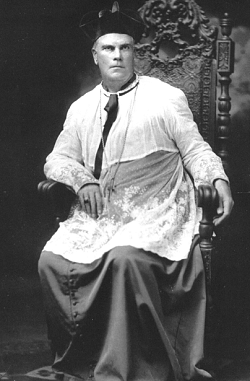The Bishops of Salt Lake City: Bishop Lawrence Scanlan, the founder

(Editor’s note: In honor of the 10th anniversary of the Bishop’s Dinner, the Intermountain Catholic is publishing a series of articles featuring the men who have served as Bishop of Salt Lake City.) By Gary Topping Archivist, Diocese of Salt Lake City
If Utah Catholics are familiar with only one of the state’s historical figures, that person is surely our first bishop, the Right Rev. Lawrence Scanlan. We’ve all seen his stern visage, scowling at us beneath his furrowed eyebrows. We think of him as our pioneer builder, some of whose structures are still with us: the Cathedral of the Madeleine with its rectory; Holy Cross Hospital (now Salt Lake Regional), St. Ann Orphanage (now Kearns-St. Ann School), Judge Mercy Home and Hospital (now Judge Memorial Catholic High School), and several early parish churches. We know this guy. And some of what we know is actually true.
It is true, for example, that he was a tough pioneer priest on the rough Western frontier. All Hallows College in Dublin, where he was trained, had been created to prepare priests to minister to Irish people driven to far-flung corners of the earth by the Potato Famine of the 1840s. Both faculty and students slept on thin straw mattresses and subsisted on simple rations designed to approximate conditions where they might have to minister. One of Bishop Scanlan’s first pastoral assignments was the wild mining town of Pioche, Nev., where he suffered physically (a head injury from being thrown from a horse, and a chronic rheumatism perhaps caused from Lyme disease contracted from a tick bite), as well as initial rejection from his hard-living Irish parishioners. But the mettle of his character was only tempered in the Nevada heat, and when he arrived in Salt Lake City in 1873, he was ready for anything.
It is also true that he was an ambitious builder, creating some truly monumental structures out of a very small Catholic population and financial base. Fortunately, at about the time he arrived, the silver mines at Park City and Alta were just beginning to produce, and some mine owners like Thomas Kearns and John Judge were Catholics whom Bishop Scanlan expected to support his church enterprises. But Bishop Scanlan was also famous for insisting that the poor muckers down in the mine shafts contribute what they could as well. He had the wisdom, too, to invite the Congregation of the Sisters of the Holy Cross to Utah, where the sisters created their own foundations: St. Mary Academy (later St. Mary of the Wasatch) and Holy Cross Hospital in Salt Lake City, as well as Sacred Heart Academy in Ogden.
There is much, though, that our popular understanding of Bishop Scanlan leaves out. For one thing, his scowl was very likely a manifestation of the pain that was his constant companion after his Nevada injuries. Late in life, he spent much time seeking relief at a hot springs in Arizona and found his ministries to be increasingly difficult. In fact, he was a very warm personality who never forgot a name, who had an especial love for small children, and enjoyed spending evenings sitting out behind his rectory, entertaining old friends.
Even less well known is Bishop Scanlan the scholar. His biographer rightly emphasizes his immense physical size and his athletic prowess at All Hallows. But Bishop Scanlan was very widely read and well-versed on philosophical and political issues. He was a tremendous linguist, competent in English, Gaelic, Latin, Greek, French and Italian, with a smattering of Spanish and even a bit of Arabic. He was one of the original faculty members at his All Hallows College for Men, which he created in Salt Lake City in 1886.
Sadly, Bishop Scanlan could not accept retirement, and long before his death in 1915 his physical problems and long absences had allowed the diocese to fall into decline. But that unhappy footnote cannot tarnish the impressive accomplishments of our founding bishop. His monuments are all around us.
(The annual Bishop’s Dinner, which supports the Cathedral of the Madeleine, this year is scheduled for Sept. 26 at The Grand America Hotel, 500 S. Main St., SLC. The guest speaker will be the Most Reverend George H. Niederauer, Archbishop emeritus of San Francisco and the eighth Bishop of Salt Lake City. For information, contact Laurel Dokos-Griffith, 801-328-8941 ext. 108.)
© Copyright 2024 The Diocese of Salt Lake City. All rights reserved.

Stay Connected With Us